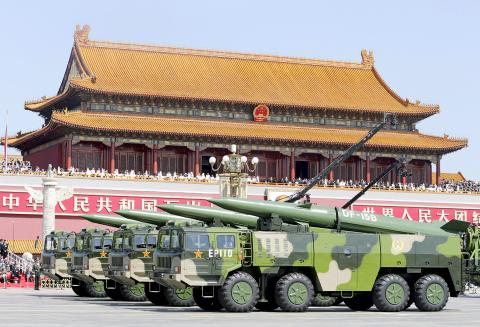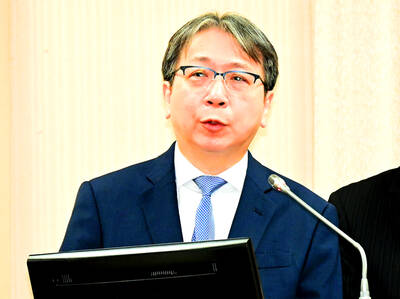Preparing a contingency plan to prevent formal Taiwanese independence remains a priority for China’s People’s Liberation Army (PLA), and Taiwan needs to step up its military investments to defend itself against China’s increasing military presence, despite a supposed improvement in cross-strait relations after the historic meeting between President Ma Ying-jeou (馬英九) and Chinese president Xi Jinping (習近平) in November last year, the US Department of Defense said yesterday.
In its annual report on military and security developments involving the People’s Republic of China (PRC), released yesterday, the department cited China’s defense white paper for last year, in which China warned against “Taiwanese separatist independence forces.”
According to the report, China said that should the clamor for Taiwanese independence intensify, it would call upon the PLA to compel Taiwan to abandon moves toward independence or unify Taiwan with China by force, while simultaneously delaying, deterring or denying any third-party intervention on Taiwan’s behalf.

Photo: Reuters
Although contingencies in the East China and South China seas and on the Korean Peninsula are increasingly important to China, “the PRC continues to focus on preparing for potential conflict in the Taiwan Strait,” the report said.
It also mentioned the potential effect president-elect Tsai Ing-wen’s (蔡英文) reluctance to acknowledge the so-called “1992 consensus” could have on maintaining peace across the Taiwan Strait.
“Following Taiwan’s January 2016 presidential and legislative elections, China has stressed that denying the ‘1992 consensus’ would make peace and development impossible,” the report said.
“President Tsai Ing-wen of the Democratic Progressive Party has pledged to maintain the ‘status quo’ in cross-strait relations, but has not endorsed Beijing’s interpretation of the ‘1992 consensus.’ Her position differs with the approach of the outgoing Kuomintang Party [Chinese Nationalist Party (KMT)],” it said.
The “1992 consensus,” is a term former Mainland Affairs Council chairman Su Chi (蘇起) admitted making up in 2000 that refers to a tacit understanding between the KMT and China that both sides of the Taiwan Strait acknowledge there is only “one China,” with each side having its own interpretation of what “China” means.
In defense budgets planned last year by the governments on both sides of the Strait, China allocated US$144 billion, while Taiwan’s budget was US$9.9 billion, the report said.
“China’s officially-disclosed military budget grew at an average of 9.8 percent per year in inflation-adjusted terms from 2006 through 2015, and Chinese leaders seem committed to sustaining defense spending growth for the foreseeable future, even as China’s economic growth decelerates,” it said.
Despite positive developments last year, such as the meeting between Ma and Xi — the first meeting between the heads of state on both sides of the Strait since 1946 — there have been no signs that China’s military posture toward Taiwan has changed significantly, it said.
At a news conference in Washington held on the same day, US Deputy Assistant Secretary of Defense for East Asia Abraham Denmark urged Taiwan to increase its defense budget.
“We have encouraged Taiwan to continue to increase its defense spending, and to invest in asymmetric and innovative capabilities and concepts,” Denmark said. “Because of the obvious and unavoidable imbalance in the sheer size of the two sides ... we believe that Taiwan does need to increase its spending, but also needs to make investments in asymmetric capabilities that would account for that natural disparity in size.”

TRAGEDY STRIKES TAIPEI: The suspect died after falling off a building after he threw smoke grenades into Taipei Main Station and went on a killing spree in Zhongshan A 27-year-old suspect allegedly threw smoke grenades in Taipei Main Station and then proceeded to Zhongshan MRT Station in a random killing spree that resulted in the death of the suspect and two other civilians, and seven injured, including one in critical condition, as of press time last night. The suspect, identified as a man surnamed Chang Wen (張文), allegedly began the attack at Taipei Main Station, the Taipei Fire Department said, adding that it received a report at 5:24pm that smoke grenades had been thrown in the station. One man in his 50s was rushed to hospital after a cardiac arrest

PUBLIC SAFETY: The premier said that security would be tightened in transport hubs, while President Lai commended the public for their bravery The government is to deploy more police, including rapid response units, in crowded public areas to ensure a swift response to any threats, President William Lai (賴清德) said yesterday after a knife attack killed three people and injured 11 in Taipei the previous day. Lai made the remarks following a briefing by the National Police Agency on the progress of the investigation, saying that the attack underscored the importance of cooperation in public security between the central and local governments. The attack unfolded in the early evening on Friday around Taipei Main Station’s M7 exit and later near the Taipei MRT’s Zhongshan

SAFETY FIRST: Double the number of police were deployed at the Taipei Marathon, while other cities released plans to bolster public event safety Authorities across Taiwan have stepped up security measures ahead of Christmas and New Year events, following a knife and smoke bomb attack in Taipei on Friday that left four people dead and 11 injured. In a bid to prevent potential copycat incidents, police deployments have been expanded for large gatherings, transport hubs, and other crowded public spaces, according to official statements from police and city authorities. Taipei Mayor Chiang Wan-an (蔣萬安) said the city has “comprehensively raised security readiness” in crowded areas, increased police deployments with armed officers, and intensified patrols during weekends and nighttime hours. For large-scale events, security checkpoints and explosives

ON ALERT: Taiwan’s partners would issue warnings if China attempted to use Interpol to target Taiwanese, and the global body has mechanisms to prevent it, an official said China has stationed two to four people specializing in Taiwan affairs at its embassies in several democratic countries to monitor and harass Taiwanese, actions that the host nations would not tolerate, National Security Bureau (NSB) Director-General Tsai Ming-yen (蔡明彥) said yesterday. Tsai made the comments at a meeting of the legislature’s Foreign Affairs and National Defense Committee, which asked him and Minister of National Defense Wellington Koo (顧立雄) to report on potential conflicts in the Taiwan Strait and military preparedness. Democratic Progressive Party (DPP) Legislator Michelle Lin (林楚茵) expressed concern that Beijing has posted personnel from China’s Taiwan Affairs Office to its